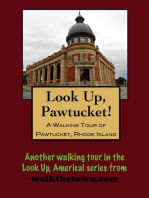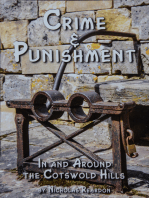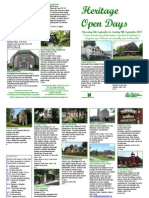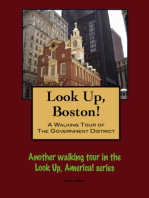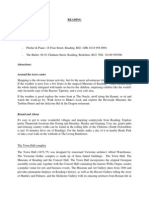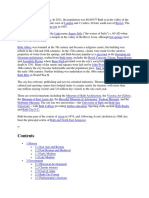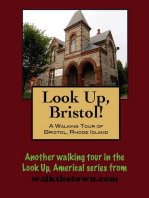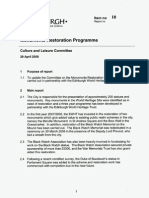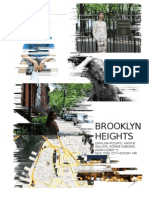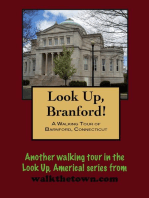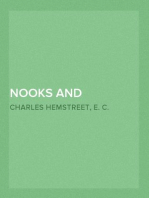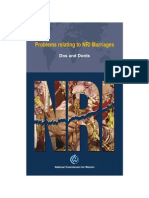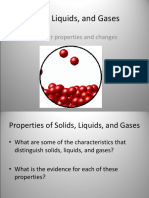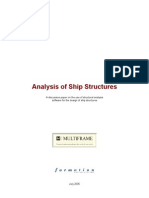Bristols Fascinating Fountains
Bristols Fascinating Fountains
Uploaded by
poonam_ranee3934Copyright:
Available Formats
Bristols Fascinating Fountains
Bristols Fascinating Fountains
Uploaded by
poonam_ranee3934Original Description:
Copyright
Available Formats
Share this document
Did you find this document useful?
Is this content inappropriate?
Copyright:
Available Formats
Bristols Fascinating Fountains
Bristols Fascinating Fountains
Uploaded by
poonam_ranee3934Copyright:
Available Formats
1
in celebration of the Redland Green Fountain Restoration and the visit to Bristol of the British Fountain Society
Historical Background
During Temple Local history Groups survey of Street Furniture we decided to focus
on our citys many public drinking fountains as a separate study. Carrying out a survey
of Bristols drinking fountains often required the "Eye of Faith" because some of those
noted in earlier accounts were completely missing. A notable example was Bristol's
famous Angel Fountain that used to be on one of the citys busiest road junctions,
opposite Bristol Bridge on the east end wall of St. Nicholas Church in the High Street.
This fountain often featured in photographs of
Bristol and was also known to many as a newspaper
seller had his pitch in front of it. However when we
enquired we were told that the only surviving pieces
were believed to be in "safe-keeping" in a
corporation store. In an attempt to find out more
about this former landmark, now only marked by the
shrapnel-pocked remains of a marble-backing slab,
we had to turn to the history books. This is the story
of what we discovered and how it put us on the trail
of many other fountains including the delight on the
Redland Hill corner of Redland Green (right).
---ooOoo---
When we started our survey we noticed that many dated from 1859 and at first we
couldn't understand what had caused the outbreak of "Fountain Frenzy". As is
usually the case, the explanation was quite simple but nevertheless an interesting
aspect of Bristol's history.
2
Bristol had its first municipal water supply in 1858, resulting in an upsurge of interest
in matters of public health. Correspondence on the subject between Mr Robert Lang
and Mr William Naish, Chairman of the Local Board of Health, was published in the
Bristol Times. To publicise the new municipal water supply and to encourage the
Temperance cause, Mr Lang proposed during the course of a Council meeting in
January 1859 that a number of drinking fountains should be erected throughout the
city. As an exemplar, he donated one hundred pounds to start the "Fountain Fund". His
public-spirited action resulted in many other donations being made by prominent
citizens during the course of the year. Turning to Arrowsmith's Dictionary of Bristol
we discovered that There are over forty fountains in different parts of the city, the
following being the principal :-
Alderman Proctor's, Clifton Down, The Promenade [recently moved across the
road]
Bath Street
Bedminster Bridge
Brandon Hill
Clifton Down [at Gloucester Row]
Colston's Avenue
Durdham Down [near the reservoir]
Hampton Road
Haymarket [St. James' Churchyard]
High Street [the aforementioned Angel Fountain]
Hotwell
Lower Berkeley Place
Neptune Statue [Victoria Street]
Nicholas street
Old King Street
Redland Green [in memory of John Bryant and Emily Clifford]
Simon Short Memorial
3
St. Philip's Bridge
St. Vincent's Spring
Stoke Road
The Triangle [Queen's Road]
Uriah Rees Thomas Memorial and Clock tower [at the top of the Blackboy Hill]
Welsh Back
Westbury-on-Trym
Today`s Fountains.
Our society, Temple Local History Group, produced a fifty-eight page illustrated
publication for the Parish Boundary Markers and Stones of Bristol (ISBN 0 951 00
68 7 8) which is used by historians and by the City to support their planning,
conservation and listing activities. For the same reason, if there is sufficient interest we
plan to produce a similar gazetteer of Bristol Fountains.
There follows a very short extract from our Fountain records which includes, in
addition to those fountains which were the subject of the tour, others in the locality
which can be seen if you visit our city.
A Three hour Tour - et seq
1 St Mary Redcliffe Vestry, Conduit, Redcliffe Hill, circa 1190
The bronze conduit outlet is set in the outside of the west wall of the churchyard
and a commemorative plaque records the granting to the church of the right of
water from Robert de Berkelys Rugewell at Knowle. The annual walk of the
pipe, a couple of miles, is an ancient Bristol custom which still takes place on the
last Saturday in September. The participants are bumped on each of the stones
that mark the route. Further details can be obtained from the vestry.
4
2 Monument, former Drinking Fountain - Somerset Square, Redcliffe
Listed Grade II Conduit head and drinking fountain, circa 1756, the date of the
square. Form: octagonal freestone structure, on pennant-stone plinth, gothic trefoil
arches, with plain columns with capped with a vase and fircone decoration.
3 Former Churchyard Drinking fountain, Temple Church, Temple
Recently fallen into disrepair, to the benefit of the adjacent publicans!
4 The Ark and Fish, Drinking Fountain, Castle Park
This design by Kate Malone and dating from 1993 is an absolute delight. It was
commissioned especially for the new park and is everything that a drinking
fountain should be - functional, aesthetically pleasing, and witty.
5 The Drinking Fountain and Maze, Castle Park
This water feature was also commissioned especially for the new park. It is situated
in the garden adjacent to the bombed shell of St Peters Church. The design
provides a fine sense of form, function and place, matching as it does the serenity
of the location.
6 Former Angel Drinking Fountain`, High Street, east wall of St Nicholas
Church
As mentioned in the introduction, this fountain, one of the results of Mr Langs
initiative, was erected by the Iron Merchants of Bristol on 19
th
November 1859. A
well-known Bristol landmark (a newspaper seller had his pitch here for many
years), it was damaged during WWII and then removed for repair. The only
remaining evidence is the shrapnel marks still visible on the church wall. A
Coalbrookdale pattern, Number 101, it was in the form of the upper three feet of an
Angels torso holding the Bible open at John IV v13 & 14, Whosoever shall drink
of these waters shall thirst again, but , with a scalloped iron basin beneath. In
addition to the wartime damage this fountain suffered from post-war neglect and
resistance from those responsible for the church structure because water from the
5
fountain was causing damp penetration of the east wall. After many years of neglect
in a city council yard, representations from the Temple Local History Group and
the Bristol Civic Society resulted in the remains being eventually moved to the
Bristol Industrial Museum. Note: there is a surviving identical Angel Fountain
from the same Coalbrookdale pattern in the centre of Birmingham, set in the
churchyard wall of St Philips.
7 Former Queen Victoria Memorial Drinking Fountain, exterior of the Market-
House wall, St Nicholas Street
Listed Grade II, this nice little brightly painted cast iron wall fountain dates from
1859. Supposedly the first public fountain to Queen Victoria, it features the young
Queen supported by cherubs. Designed by Wills Bros of Suffolk, sculpted by Payne
and paid for by Mr Budgett, a Bristol Grocery Merchant, it is from the
Coalbrookdale catalogue, pattern number 106. The iron back plate and basin were
damaged and in 1982 the basin was rebuilt in concrete/resin. Until recently the
fountain was kept painted by a Mr John Hewett of Whitehall in Bristol.
8 St 1ohn`s Conduit, outlet in the City Wall beneath St 1ohn`s Church
Although known locally as St Johns Conduit, it is more correctly referred to as
The Carmelite Pipe. The pipe was named after the White Friars who in 1267 took
the water from their springs on the slopes of Brandon Hill (top of Park Street) to
their house in Colston Street (the present-day Colston Hall occupies the site). The
St John's conduit house is a recent addition, i.e. 1376, and arises from the granting
of a branch or Feather to the parishioners of St Johns. With the dissolution of the
monasteries the water supply reverted to the Parish and the City. During the blitz
of the last war this provided the only source of potable water for the local residents.
The water had run continually until the effects of an upsurge in building
development caused it to stop for a number of years. As a result of entreaties from
every interested group and organisation, it appears that the City has now finally
found and fixed the break in the underground pipe! Full details of this very
complex system are contained in the Temple Local History Group publication
6
entitled An account of St Johns Conduit ~ Bristols Medieval Water System
(ISBN 0 951 0068 0 0).
9 Horse trough with dog basin, north side of Colston Avenue by the Cenotaph
This dates from 1908; the inscription reads: In grateful memory of Captain R. B
Nicholetts R.N. who died August 14
th
1908. This trough is erected for the use of
animals of whom he was always the unfailing friend and champion. Blessed are the
merciful.
10 Former Drinking Fountain, Industrial & Fine Art Exhibition, Colston Avenue,
adjacent to the statue of Edward Colston
This square Grade II listed polished grey and red granite fountain with brass Coat
of Arms of the City and lion head spouts was erected to celebrate the success of the
exhibition held on the site (known locally as Magpie Park) in 1893. The exhibition
raised 2,200 for five local medical charities and the fountain, which cost 220, has
a descriptive plaque giving further details and names of the committee members
responsible for its erection.
11 Former Parish Pump, St Stephen`s Churchyard
This 19
th
century pump set in the wall of the churchyard faces outwards for the use
of the parish and is unusual in that it is box cased in cast iron panels. Although no
longer in use, it has been maintained in recent years by members of Temple Local
History Group as a thank you for help received from the vestry.
12 Bristol`s newest water feature, The Centre`
Forty-ish computer controlled small jets and a cascade must be seen to be
believed; viewed by many Bristol taxpayers as controversial.
7
13 King George V Fountain, on Narrow Quay side of Broad Quay House
Nice use of monumental figures from the former CWS building, replaced by Broad
Quay House completed on the 27
th
May 1982 with a grant of 25,000 from the
King George V Memorial Fund. (both sides illustrated below)
14 Sabrina and her attendants, in courtyard of Broad Quay House, Narrow Quay
In a private courtyard, normally accessible during office hours but still visible from
the quayside out of hours, this design is by George Laing. This fountain tucked
away in the courtyard is an often-overlooked delight.
15 The Millennium Fountain, Millennium Square, Canon`s Marsh
An excellent laminar flow fountain, but who will be the first visitor to get a wet
seat? Visit it to see what we mean! The square and surrounding attractions look
like becoming a vibrant new centre for Bristol - what the city has long needed.
That concludes the tour around the central area of the city - a mornings
tour. The following list gives others that you might like to see during your
visit. Although a walking tour encompassing all of them would be
onerous and a bus tour time consuming and very expensive, it would be
feasible to visit most if not all of them by car.
8
v Computer Controlled Water 1ets, Cribbs Causeway Shopping Mall
Good, but it would be nice to see more of the possible programmes used.
(illustrated)
v King Edward VII Memorial Fountain, Victoria Rooms
Grade II Listed. dated 1912, designed bv Rickard & Poole, and newlv restored to
its former glorv, a fine combination of Art, Form, Function and modern technologv
there is even an anemometer (wind speed gauge) to control the fountain water
pressure so that on windv davs the pressure is reduced in order that the water does
not blow across the adfacent roadwav'
v Preaching Cross and former Drinking Fountain, St 1ames` Churchyard
The restoration of this cross (the shaft is broken and the tabernacle head is
missing) is another proposed TLHG profect. The stepped base contains a now
defunct drinking fountain and basin.
v Alderman Proctor`s Drinking Fountain, Clifton Down
Grade II Listed. it was erected in 1872 to record the liberal gift to the citi:ens of
Bristol of the rights of use and access to the Clifton & Durdham Downs for ever
preserved bv an Act of Parliament. In 1906 this triangular Gothic structure of Bath
Stone with a pointed arch supported bv pink granite columns on each face was
considered to be '.one of the prettiest designed fountains in Bristol`. Originallv
sited at the head of Bridge Jallev Road, it was causing a traffic ha:ard and in the
9
1980s was moved to its present location on the grass on the opposite side of the
road. The new location allows easier and safer access and has the merit of being in
sight of the Mansion House, the Lord Mavors official residence, itself given to the
Citv of Bristol bv Alderman Proctor. The relocation was also used as the
opportunitv for a mafor restoration programme.
v Drinking Fountain, Clifton Down
(Suspension Bridge end of Gloucestershire Row) This fountain has an elaborate
four columned cast iron canopv bv McFarlanes of Glasgow let down bv a modern
(1980s) column tvpe push button fountain (but at least it works'). A twin of this
fountain can be seen outside the Aorth Melbourne Post Office, Australia.
v Queen Victoria Diamond 1ubilee Memorial Drinking Fountain, The Green,
Shirehampton
The four columned cast iron canopv bv McFarlanes of Glasgow is similar to that
at Gloucester Row but the fountain and basin are verv elaborate with a bird (heron
or stork) as a supporter for the now missing chained cups. These verv popular
designs were registered in 1860 and used throughout Great Britain and the
Empire.
v Simon Short Memorial Fountain, Hotwells
Grade II Listed. erected in 1902 as a memorial to Simon Short, one of the
originators of the Seamans Institute and manv other movements for their welfare.
Originallv sited on Bristol Docks Companv land it was moved to the present
location and restored when the site was needed for the new Cumberland Basin
traffic svstem. Currentlv in front of a Knightstone Housing development, planning
permission was conditional upon the inclusion of maintenance bv the developers.
v Uriah Rees Thomas Memorial Drinking Fountain and Clock Tower, Blackboy
Hill
Grade II Listed. erected in 1904, the Rev U. R Thomas was the first Minister of
10
Redland Park Chapel, a position he held for fortv vears, until his death in 1901.
His memorial is a massive octagonal structure in polished pink granite complete
with five basins, a tiled roof and cupola containing an electric clock bv Kemp Bros.
The clock is the subfect of an annual maintenance contract but sadlv the water
supplv is not'
v Drinking Fountain, at entrance to St Andrew`s (Birdcage) Walk, St Andrew`s
Churchyard, The Fosseway, Clifton
Grade II Listed. the Clifton & Hotwells Improvement Societv (CHIS) is currentlv
trving to raise the funds to get this late 19th centurv fountain restored.
vMaze fountain, Victoria Park
Built in 1984, it lies on the route of the Redcliffe Pipe. Water from the conduit
svstem is diverted to flow through the thirtv-foot diameter Christian Ma:e design.
The ma:e design was chosen because it replicates one of the medieval roof bosses
within St Marv Redcliffe Church. In 1984 a mafor civil engineering profect took
place beneath Jictoria Park and the construction of this fountain was seen as a
significant link, both between the Citv and the Church and as a profect spanning
nearlv eight centuries of parish historv. As a final note, fund raising associated
with the construction of the ma:e fountain resulted in sufficient funds being raised
to provide a water supplv for a village in Africa.
v Gaius Sentius`, Drinking Fountain, Warmley
(on the Bristol to Bath Cvcle path) Designed bv Gordon Brown, this must be
Bristols most marvellous and imaginative modern drinking fountain. It is reallv
worth driving to drink for we mean, of course, cvcling and water'
v Cllr W.D.Watts Memorial (former) Drinking Fountain, Horfield
(function of Kellawav Avenue & Wellington Hill) This is another splendid example
of the work of the McFarlane Iron Foundrv, recentlv restored bv the Citv and once
more complete with WORKING lamp' The twentv foot high green painted fountain
11
in the form of a lamp-standard combines drinking fountains and animal troughs
and now stands on the grass verge at the corner of Kellawav Avenue and
Wellington Hill. However, it was originallv located at the bottom of the locallv
known Pig-Stv Hill, also in Horfield. In the 19th centurv there were stables
nearbv for the trace horses needed to help heavilv laden carts up the hill - and Im
sure that the fountain was welcomed bv all, whether two or four legged' Although
twentieth-centurv road widening resulted in the removal of the fountain it was
fortunatelv saved to its new location, albeit sans gas-lamp or water supplv. Everv
fountain and watering hole in Bristol has a storv attached, and we have managed
to record manv of these historical and anecdotal details.
v Goldney House Grotto and water features
(Universitv Hall of Residence, Clifton) A classic example of Jictorian landscaping
and follv construction. Of course it alwavs helps if vou are a merchant who can
instruct vour Captains to bring shells and corals back with them from their trading
vovages.
That concludes this brief overview of some of Bristols fountains and water features -
however, there are many more! For more information contact us using our on-line
enquiry form.
In addition to those listed above, some fountains were combined with cattle and other
animal troughs. The first of these was provided by the SPCA at the Jacob's Wells and
opened on September the 7th 1883. Many drinking troughs were provided by the
ladies of the Metropolitan Cattle & Horse Trough association.
Sadly the first fountain resulting from the setting up of the "Fountain Fund" in 1859 by
Mr Robert Lang, which was a Coalbrookdale design and located at the Triangle in
Clifton, succumbed to road widening and is no more.
12
The background to some of the fountains is shrouded in the mists of time. What of
John Bryant and Emily Clifford who sponsored the Redland Green Fountain? Who
were they and why were their names linked? In an attempt to find out we delved into
the history books, so far, alas, without success. Were they linked by a joint
philanthropic venture, or by a common tragedy? Was the selection of the flowers on
the carved stone support for the fountain purely for aesthetic reasons or do they
represent a significant link? Whatever the story behind the presence of their names on
this delightful little fountain, we are pleased to have been invited to contribute to its
restoration celebrations and congratulate the enthusiasts of Redland & Cotham
Amenity Society whose hard work made it possible. We believe that this project
validates our stated aim of "Having an interest in the past with a concern for the
future". Thank you RCAS for restoring this bit of Bristol's history for the rest of us to
enjoy.
Temple Local History Group has been pleased to provide a photographic display of
some of the fountains mentioned and we would be pleased to learn of any that we have
missed.
Date: 27.09.1994 & 22-23.07.2000 TLHG Library Classification: 7.6 & 11
File ref: \\Walks\Explorer\Bristol Fountains a tour.doc
More will be added to this pamphlet as information becomes available.
You might also like
- Womens Wear DraftingDocument31 pagesWomens Wear Draftingpoonam_ranee3934100% (24)
- Quality Control Manual Papua New GuineaDocument59 pagesQuality Control Manual Papua New Guineapoonam_ranee3934No ratings yet
- Domex 650 MC Hot Rolled, Extra High Strength, Cold Forming SteelDocument2 pagesDomex 650 MC Hot Rolled, Extra High Strength, Cold Forming SteelBo WangNo ratings yet
- Ballymoney Heritage Guide 2009Document8 pagesBallymoney Heritage Guide 2009manda84No ratings yet
- Bristol Walking TourDocument12 pagesBristol Walking TourRuxandra MorosanNo ratings yet
- Look Up, Charleston! A Walking Tour of Charleston, South Carolina: Walled CityFrom EverandLook Up, Charleston! A Walking Tour of Charleston, South Carolina: Walled CityRating: 2 out of 5 stars2/5 (1)
- London: ST Paul's Cathedral Is AnDocument3 pagesLondon: ST Paul's Cathedral Is AnNicolle13No ratings yet
- Cumberland Piazza Heritage StatementDocument17 pagesCumberland Piazza Heritage Statementray_smith1099No ratings yet
- History of Christ ChurchDocument44 pagesHistory of Christ ChurchJulie Westerby100% (1)
- Crime & Punishment: In and Around the Costwold Hills: In and Around the Costwold HillsFrom EverandCrime & Punishment: In and Around the Costwold Hills: In and Around the Costwold HillsNo ratings yet
- Stottesdon BookletDocument16 pagesStottesdon Bookletapi-727074110No ratings yet
- Bristol High Cross - DissertationDocument2 pagesBristol High Cross - DissertationJennifer AdvientoNo ratings yet
- City of London ChurchesDocument90 pagesCity of London Churchescorinne mills100% (8)
- Bath and Bristol - Painted by Laura A. Happerfield, Descibed by Stanley HuttonFrom EverandBath and Bristol - Painted by Laura A. Happerfield, Descibed by Stanley HuttonNo ratings yet
- Oakham & the Villages Through Time: Cottesmore, Empingham, Greetham, Langham, Market Overton and WhissendineFrom EverandOakham & the Villages Through Time: Cottesmore, Empingham, Greetham, Langham, Market Overton and WhissendineNo ratings yet
- Kingston Heritage Open Days 2012Document4 pagesKingston Heritage Open Days 2012Matthew ReesNo ratings yet
- Friday Night:: ReadingDocument4 pagesFriday Night:: ReadingGrand-Master-FlashNo ratings yet
- Trust Topics: Doncaster Civic Trust NewsletterDocument12 pagesTrust Topics: Doncaster Civic Trust NewsletterIan MooreNo ratings yet
- Preservation Master Plan: Bridge Street Cemetery Northampton, MassachusettsDocument48 pagesPreservation Master Plan: Bridge Street Cemetery Northampton, MassachusettsMary SerrezeNo ratings yet
- Northover Mill History and SettingDocument5 pagesNorthover Mill History and SettingC & N HollinrakeNo ratings yet
- WN For Its RomanDocument6 pagesWN For Its Roman1234567890qwertyuiopNo ratings yet
- Culture+leisure 29.04.08 10.00am Item 10Document18 pagesCulture+leisure 29.04.08 10.00am Item 10Phyllis StephenNo ratings yet
- Bell's Cathedrals: The Cathedral Church of Lincoln A History and Description of its Fabric and a List of the BishopsFrom EverandBell's Cathedrals: The Cathedral Church of Lincoln A History and Description of its Fabric and a List of the BishopsNo ratings yet
- Brooklyn HeightsDocument11 pagesBrooklyn HeightsCatalina PiccatoNo ratings yet
- Problems Relating To NRI Marriages: Dos and DontsDocument6 pagesProblems Relating To NRI Marriages: Dos and Dontspoonam_ranee3934No ratings yet
- JAM 2014 BrochureDocument30 pagesJAM 2014 BrochureRahul MehtaNo ratings yet
- Stone IndiaDocument20 pagesStone Indiapoonam_ranee3934No ratings yet
- MBA For Working ExecutivesDocument7 pagesMBA For Working Executivespoonam_ranee3934No ratings yet
- Program Final WebDocument60 pagesProgram Final Webpoonam_ranee3934No ratings yet
- Lynn Allen's AutoCAD 2014 Tips and TricksDocument17 pagesLynn Allen's AutoCAD 2014 Tips and TricksZoltán NémethNo ratings yet
- Survey - Women-Cosmetics IndiaDocument17 pagesSurvey - Women-Cosmetics Indiapoonam_ranee3934100% (1)
- Garment Construction - Amina CreationsDocument74 pagesGarment Construction - Amina Creationspoonam_ranee3934100% (2)
- Pattern MakingDocument16 pagesPattern Makingpoonam_ranee3934100% (2)
- Basic Simple PresentationDocument37 pagesBasic Simple PresentationAngelica EsguireroNo ratings yet
- 1bchemical MixturesDocument5 pages1bchemical MixturesCarlene Ashley AcebesNo ratings yet
- The Chemistry of The Colorful FireDocument9 pagesThe Chemistry of The Colorful FireHazel Dela CruzNo ratings yet
- BAS-101 - Practice Questions Unit 4Document1 pageBAS-101 - Practice Questions Unit 4ᴀᴍᴀɴNo ratings yet
- The Right Form of VerbsDocument17 pagesThe Right Form of VerbsKniliasNo ratings yet
- Lazy Tongs ApplicationsDocument9 pagesLazy Tongs Applicationsعبدالمحسن علي ENo ratings yet
- TransCAD - An Overview of A Transportation Planning and Analysis Software AbstractDocument3 pagesTransCAD - An Overview of A Transportation Planning and Analysis Software AbstractJohn Arnold NovillaNo ratings yet
- Main CatalogDocument151 pagesMain CatalogНикита МельниковNo ratings yet
- Ste-Worksheet Allan IsaacDocument7 pagesSte-Worksheet Allan IsaacallanisaaaacNo ratings yet
- Summative Test in Mathematics Grade V Module 1-4 First Quarter Name: - TeacherDocument2 pagesSummative Test in Mathematics Grade V Module 1-4 First Quarter Name: - TeacherKhairiyah GogoNo ratings yet
- Model No.: N140Bge Suffix: Eb3: Product SpecificationDocument33 pagesModel No.: N140Bge Suffix: Eb3: Product SpecificationGilmer Arauco AlarconNo ratings yet
- Phase 2Document8 pagesPhase 2Eshan SNo ratings yet
- Chemistry Practical File-Physical ChemistryDocument11 pagesChemistry Practical File-Physical ChemistryUjjwal PandeyNo ratings yet
- Outokumpu Core Range Datasheet PDFDocument16 pagesOutokumpu Core Range Datasheet PDFMeow SuthidaNo ratings yet
- Bangladesh AbDocument10 pagesBangladesh AbAbdul RehmanNo ratings yet
- Constitutional Provisions For Environment Protection in Indian LawDocument14 pagesConstitutional Provisions For Environment Protection in Indian LawsudarshanaNo ratings yet
- Blood VesselsDocument4 pagesBlood VesselsNeel GamiNo ratings yet
- 20559832Document4 pages20559832Yian 1No ratings yet
- Erection Protocol at Dalmia Nashik - RemovedDocument17 pagesErection Protocol at Dalmia Nashik - Removedshuklasaurabh767No ratings yet
- Solid, Liquids, and GasesDocument27 pagesSolid, Liquids, and GasesHamass D MajdiNo ratings yet
- MultiFrame ShipAnalysisDocument40 pagesMultiFrame ShipAnalysisPoowadol NiyomkaNo ratings yet
- Simpson's 1/3 Rule of Integration: Major: All Engineering Majors Authors: Autar Kaw, Charlie BarkerDocument32 pagesSimpson's 1/3 Rule of Integration: Major: All Engineering Majors Authors: Autar Kaw, Charlie BarkerAlden TomonghaNo ratings yet
- Write Short Notes On The Working Principle of Master CylinderDocument4 pagesWrite Short Notes On The Working Principle of Master CylinderSír ProsaNo ratings yet
- Pump and Ump Scam SecDocument62 pagesPump and Ump Scam SecZerohedge100% (1)
- PED 106 Physiology of Exercise and Physical Activity)Document9 pagesPED 106 Physiology of Exercise and Physical Activity)Glory Grace E. LimcoNo ratings yet
- List of Ebm Users TaxpayerDocument179 pagesList of Ebm Users TaxpayerMaurice GasanaNo ratings yet
- SOAL USBN English Conversation Kelas 9Document11 pagesSOAL USBN English Conversation Kelas 9Elvira LolangionNo ratings yet
- Flow Analysis of Butterfly Valve Using CFDDocument7 pagesFlow Analysis of Butterfly Valve Using CFDIJMERNo ratings yet
- Pranahuti - TransmissionDocument80 pagesPranahuti - TransmissionShiv KeskarNo ratings yet















